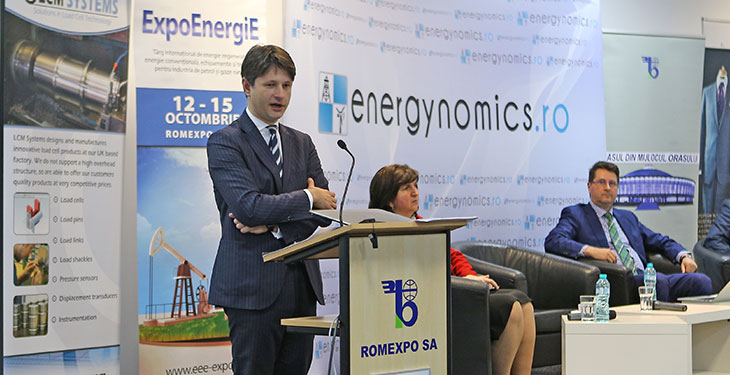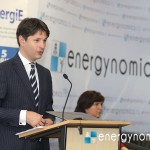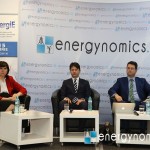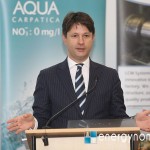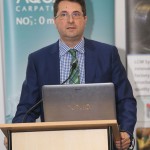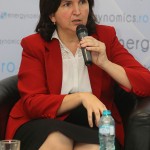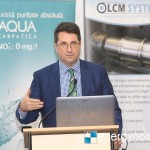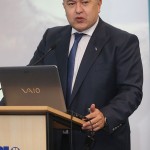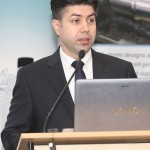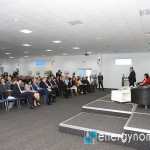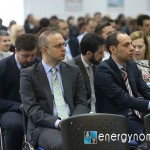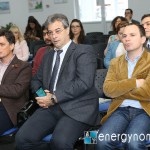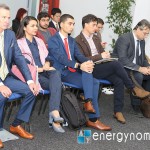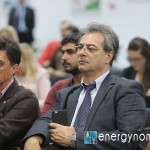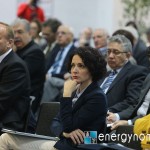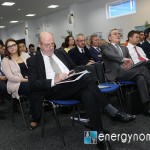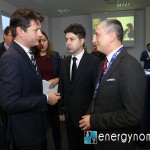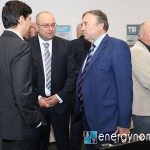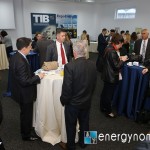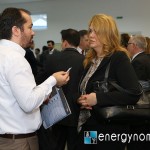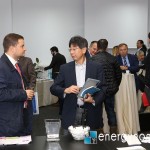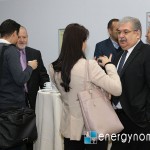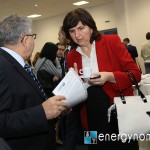* The first preliminary data from the quantitative analysis for the national strategy, presented at the event organized by energynomics.ro and Romexpo, in the opening of ExpoEnergiE
Romania’s energy strategy puts the consumer in the center and it is built around five overarching objectives. At its heart is the “Modernising of the Energy Governance system” and the document, now being in the final phase of development at the Ministry of Energy, will be the starting point in this regard: the first mathematical modeling, using data comparable to those used in Europe to design the future energy system in Romania on three main development scenarios for 2030.
The Minister of Energy Victor Grigorescu exhibited for the first time at the conference “Romanian engineering for the new energy revolution” the preliminary data resulting from the quantitative analysis which is still undergoing with the consortium of Ernst & Young and E3Modelling. The final form of the Romanian Energy Strategy for 2016-2030, with the perspective for 2050, will be published in the coming weeks, the representatives of the Ministry of Economy promised. After the public debates, the document will be assumed by the Romanian Government.
Radu Dudău, advisor to the Ministry of Energy, responsible for developing the National Energy Strategy, set forth the preliminary findings of the quantitative modeling, which shows that for the next 10-15 years, the required investments for the energy sector could reach up to 1.5 – 2 billion euros per year. The official said that the final strategy will detail the investment destinations on each sector.
The Ministry of Energy’s calculations show that energy prices will increase to the final consumer by 2030, amid the gradual increase, especially after 2020, of the price of fossil fuels. Furthermore, investments in infrastructure for transport and distribution will be reflected in the final consumer price. Radu Dudău stated, however, that within the mentioned timeframe “the increase of the living standards will offset more expensive energy, so that the share of energy costs could remain constant.”
Energy consumption will increase slightly
Preliminary calculations presented by the Ministry of Energy show that until 2030, the final energy consumption will increase slightly, remaining between 20 and 23 million tonnes of oil equivalent (toe). Projections indicate that the industry will maintain a share of about 30%, and the residential consumption and the tertiary consumption will decrease slightly (from 33.6% in 2015 to 31.7% in 2030 – respectively 11.1% in 2015 to 10.3% in 2030). Consumption in transport alone will increase at a much significant share: from 26.1% of the total in 2015 to 28.4% in 2030.
For the household consumers, the natural gas consumption is expected to grow to represent over 42% in 2030 (compared to 30.5% in 2015), in the detriment of the biomass (firewood), whose share would reduce by half (from 40.7% of the total in 2015 to 19.8% in 2030). Overall, the final energy consumption in the housing sector will fall below 7 million toe in 2030, after small increases in the range 2015-2025.
Energy production will increase by 17.5% by 2030
The Ministry of Energy’s projections indicate a substantial advance in the electricity production over the next 15 years, from 61.06 MWh in 2015 to 72.77 MWh in 2030. This will be even while the installed capacity would rise by only 12% (from 21.14 GW, the GW 23,68).
The energy mix will remain balanced:
- Water 25% (2015) – 26% (2030)
- Nuclear 17% (2015) – 16% (2030)
- Wind 8% (2015) – 22% (2030)
- Solar 2% (2015) – 6% (2030)
- Coal 34% (2015) – 5% (2030)
- Natural gas 12% (2015) – 21% (2030)
- Biomass 1% (2015) – 3% (2030)
Increased role for natural gas
The mix of electricity will see an increase for the role of natural gas as a transition resource towards decarbonisation, despite its anticipated decline in the onshore production, with increased depletion for deposits in operation, mainly in the scenario of maintained low prices on the international markets. The topic was also addressed by the Minister Victor Grigorescu, who said that Romania must immediately solve the problem of the oil and gas reserves decline, as oil projects require a long time to be developed. “We did very little exploration, and the fact that the proved reserves are on a descending course means that we must focus more heavily on this area”, said the minister.
One unpredictible element that could have a major impact upon the projections is the gas from the Black Sea entering (or not) in the production. On this theme, Radu Dudău said that a so-called “stress test” is to be made, whereas the production in the Black Sea has an important role in ensuring the security of supply, but also a great potential impact in economic terms.
The share of renewables could fall
“At a still high capital cost, the share of RES could decline in 2030 compared to 2015, in the absence of a new support scheme” shows the preliminary findings of the quantitative modeling, presented by the Ministry of Energy at “Romanian engineering for the new energy revolution”. In the most optimistic scenario, the share of renewables in the electricity mix could exceed 80%, by 2050. Radu Dudău has stated that projections in this sector, as well as all the others, did not take into account major changes in the national legal framework (ie. imposition of any limitations on the purchase of cars propelled by engines with internal combustion, following examples od already implemented or under discussion models in the Netherlands and Germany), the mandatory targets at EU level (eg. the price of ETS allowances) or accelerated evolution of new technologies (electric cars, electricity storage, gasification etc.).
Coal is essential for a resilient energy system
Another unpredictable element is related to the coal sector. On the one hand, the decisions to be taken at European level on the price of ETS allowances will put an increased pressure on the producers in this sector. Meanwhile, coal as a strategic resource for ensuring the resilience of the national energy system could benefit from special treatment, allowing a smooth transition to other types of resources, in the next 15-20 years.
This is one of Romania’s energy policy priorities for the next period. Corina Popescu, State Secretary in the Ministry of Energy, said at the conference “Romanian engineering for the new energy revolution” that, once completed, the energy strategy will provide the analytical instrument and the documented data so that Romania’s representatives to be able to support favorable positions for the national economy in the debates already under way at European level. “We have focused our analyzes on the 2030 timeframe for in the next period we will have to negotiate the 2030 targets. In the coming period, there will be a great effervescence in Europe because we are before the changing and the publication of five major directives with significant impact on Romania. I’m talking about the renewables directive, the directive on energy efficiency, the new market design directive, the directive on CO2 and the energy governance directive. If we will know how to play our cards, we could become a pole for intelligence and best practices transfer from the Central Europe to the South-Eastern Europe, an area with potential for growth,” said Corina Popescu.
Strategy – a tool for good governance
Energy strategy and the quantitative modeling come with the present image of the Romanian energy system and with the econometric projections that can be calculated at the moment. They should be accompanied by instruments for dynamic evaluating, so that the energy governance (mainly the the Executive’s and Parliament’s decisions) to become more flexible, transparent and consistent. Only after modernizing the energy system of governance the other goals may be pursued: energy security, clean energy, competitive markets, in order to reach the core objective: to reduce energy poverty and to protect vulnerable consumers..
“Romanian engineering for the new energy revolution” was an event organized by energynomics.ro and Romexpo, under the auspices of the Ministry of Energy, with the support of Siemens, LCM Systems, Roycroft & Ross, with the strategic partner ACUE – Federation of Associations Companies Utilities Energy and media partners: Radio România Actualităţi and Radio România Bucureşti fm.
Over 180 experts, representatives from ABIEC, the Romanian Academy, Accomodation, ACUE, Aderro GP Energy, Adrem, Agerpres, Aggreko, ALD Automotive, the Embassy of China, the Embassy of Bulgaria, the Embassy of Rusia, the Embassy of U.S.A., the Embassy of Hungary, Amromco, ANRE (National Regulatory Authority for Energy), NAMR, ARBIO, ARPEE, ASE, the Association of electricity Suppliers in Romania – AFEER, the Association for studies and Forecasting Economic and the Aspen Social Aspen, Banca Transilvania, BCR, BCR Pensii, BERD, Bioenergy Suceava, Black Sea Oil & Gas, Brikston Construction Solutions, Brinel, BT Capital Partners, Bteam, BVB, the Romanian-German Chamber of Commerce and Industry (AHK Romania), Can & Power, casadetraduceri, CCIR, CEC Bank, CEMS, CMS, CNR-CME, Complexul Energetic Oltenia, Conpet, the Competition Council, Control Point, DNV GL – Oil & Gas, Electra Norte, Electromagnetic SA, Elsaco Esco, Enel Energie, Energobit, EnergoNuclear Energy-Serv SRL, Escorom, Evenimentul Zilei, Exxon Mobil, Photo Services, GE Power Services, GestampWind, Govnet, Greenpeace Romania, Hidroconstrucţia, Hidroelectrica, Hidro Tarniţa, Honeywell Romania SRL, Horvath & Partners, Hunt Oil Company of Romania, INCDIE ICEMENERG Invest Energy, Jereh, JIS Consulting Ltd, Kerui Petroleum Equipment, KPMG, LCM Systems, Lukoil Lubricants, Lukoil Petrotel-, Mazars Romania SRL, Ministry of Energy, Mitsubishi, Nei Guard, News.ro, NEXTENERGIES Consultants, NIS Petrol, NKT Cables, OMV Petrom, Patres , Petprod financial market, PNE Wind Romania, Radio Romania news, RATEN, RBSTA, Repower, magazine economist, ROA, Romania Press, Romania TV, Romelectro Romgaz ROPEPCA, Rottco, Royal Danish Embassy, Roycroft & Ross, S & T, SC Q SRL, Serban & Musneci, Siemens Romania, SIPG, Smart EPC OM SRL, Telekom Romania, Unicredit, Union Cont Expert, Univers Ingineresc, Valmet Technology Valmet, Video Services, Voith Hydro, Voith Turbo, WPD, WSB Energie Verde SRL attended the conference and participated at the debate.
